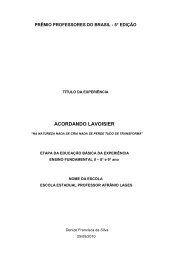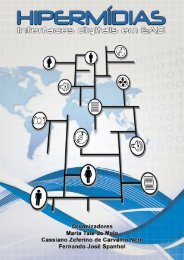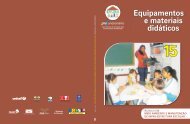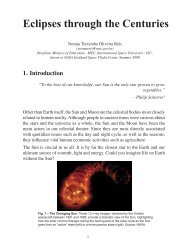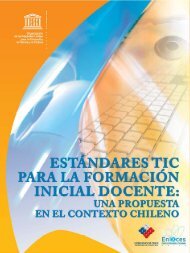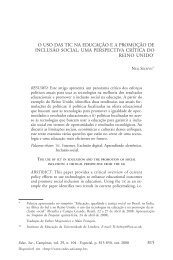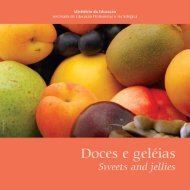BIO-CULTURAL COMMUNITY PROTOCOLS - Portal do Professor
BIO-CULTURAL COMMUNITY PROTOCOLS - Portal do Professor
BIO-CULTURAL COMMUNITY PROTOCOLS - Portal do Professor
You also want an ePaper? Increase the reach of your titles
YUMPU automatically turns print PDFs into web optimized ePapers that Google loves.
PART II / CHAPTER 5<br />
processes of free, prior and informed consent (FPIC) and<br />
community research agreements that establish mutually<br />
agreed terms (MAT). During the course of the study, there<br />
should be periodic participatory evaluations that assess the<br />
perspectives of a broad range of community members to<br />
ensure there is general agreement about the research<br />
approach, methods and results. A BCP can serve to establish<br />
the terms and conditions of any transfer of knowledge and<br />
resources outside the community, which should cover<br />
disclosure through internal reports, published materials<br />
and web-based bioinformatics and mapping approaches<br />
such as searchable ethno-biological databases and<br />
online mapping.<br />
Bio-prospecting has yielded valuable commercial products in<br />
recent history and protected areas are seen as reservoirs of<br />
genetic materials that might serve important functions in<br />
agriculture or medicine. Bio-prospecting in protected areas is<br />
bound to increase as they contain much of the world’s<br />
biodiversity and are likely to serve as increasingly important<br />
repositories of disappearing habitats, species and genetic<br />
resources. 12<br />
As national ABS frameworks are developed, bioprospecting<br />
agreements with protected areas are also likely<br />
to increase because management authorities see them as<br />
a promising source of sustainable financing. In this context,<br />
BCPs can be a crucial instrument to ensure that the rights<br />
of ILCs in and around protected areas over their resources<br />
and knowledge are respected, that bio-prospecting activities<br />
take place only after FPIC is established, and that ILCs receive<br />
a fair share of the benefits arising out of such agreements.<br />
BCPs can inform researchers about appropriate researcher<br />
behavior, the community’s research priorities, local<br />
requirements for obtaining FPIC, and the types of<br />
benefits that should be shared.<br />
2.3 Bio-cultural Community Protocols<br />
and Indigenous and Community<br />
Conserved Areas<br />
ICCAs are defined as “natural and/or modified ecosystems<br />
containing significant biodiversity values, ecological services<br />
and cultural values, voluntarily conserved by indigenous<br />
<strong>BIO</strong>-<strong>CULTURAL</strong> <strong>COMMUNITY</strong> <strong>PROTOCOLS</strong> AND PROTECTED AREAS<br />
peoples and local communities – both sedentary and<br />
mobile – through customary laws or other effective means”. 13<br />
Territories and lands occupied or used by ILCs encompass a<br />
considerable proportion of areas important for biodiversity<br />
and wildlife conservation. They are found in both terrestrial<br />
and marine areas and range in size from sacred groves of less<br />
than 1 ha to over 30 000 km 2 indigenous territories in Brazil. 14<br />
Many of these ICCAs encompass conservation knowledge<br />
and practices intertwined with local strategies for livelihoods,<br />
the spiritual and material values of ILCs and a variety<br />
of customary and legal collective rights over land and<br />
natural resources.<br />
ICCAs have until recently largely been ignored, if not<br />
undermined, by formal conservation policies and many are<br />
under severe threat. However, the recent recognition of<br />
ICCAs at the international policy level is encouraging, and<br />
in some countries ICCAs have been recognized and<br />
incorporated into national protected area systems.<br />
For example, about 20% of Australia’s protected area consists<br />
of 20 indigenous protected areas. 15<br />
Despite this, the interface<br />
between state-based institutions and the customary<br />
institutions of ILCs remains a challenging and complex arena.<br />
All too often, the official recognition of the conservation<br />
value of ICCAs and their incorporation into national protected<br />
area systems is achieved through the imposition of new<br />
institutions that undermine the very customary governance<br />
structures and bio-cultural values that conserve the ICCAs<br />
in the first place. Additionally, under the influence of rapid<br />
economic, demographic and cultural changes, the traditional<br />
knowledge, values and practices linked to ICCAs are often<br />
being aban<strong>do</strong>ned or lost.<br />
At the same time, public recognition of ICCAs can be crucial<br />
for some communities to be able to defend these areas against<br />
external threats or to seek various forms of support for the<br />
management of their natural resources. Indeed, the recognition<br />
of ICCAs needs to be based on the respect of the communities’<br />
strategies for conservation and sustainable use and their<br />
customary governance institutions. It should take into account<br />
the range of bio-cultural values that help conserve the area<br />
and the role these values play in the communities’ ways of life.<br />
12. United Nations University Institute of Advanced Studies (UNU/IAS), Biodiversity Access and Benefit–Sharing Policies for Protected Areas, an Introduction. UNU/IAS, Tokyo, 2003.<br />
13. Borrini-Feyerabend, Grazia, Recognizing and Supporting Indigenous and Community Conservation – Ideas and Experiences from the Grassroots, IUCN CEESP.<br />
Briefing Note 9, September 2008.<br />
14. See: Kothari, Ashish, Community Conserved Areas: Towards Ecological and Livelihood Security, in: PARKS 16, pp 14-20, 2006; and Berkes, Fikret, Community<br />
Conserved Areas: Policy Issues in Historic and Contemporary Context, in: Conservation Letters 2, pp 19-24, 2009.<br />
15. Smyth, Dernoth, Indigenous Protected Areas in Australia, in: PARKS 16, pp 14-20, 2006.<br />
55





